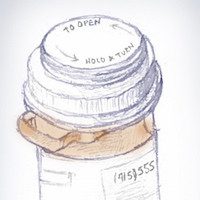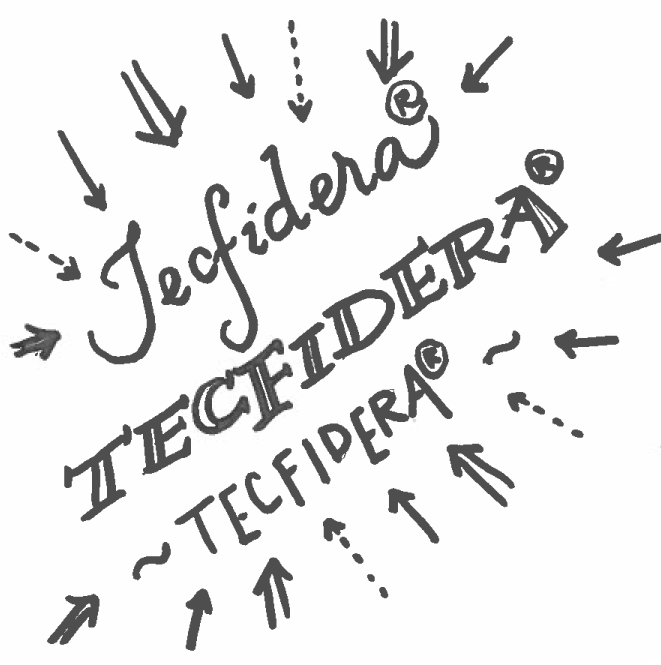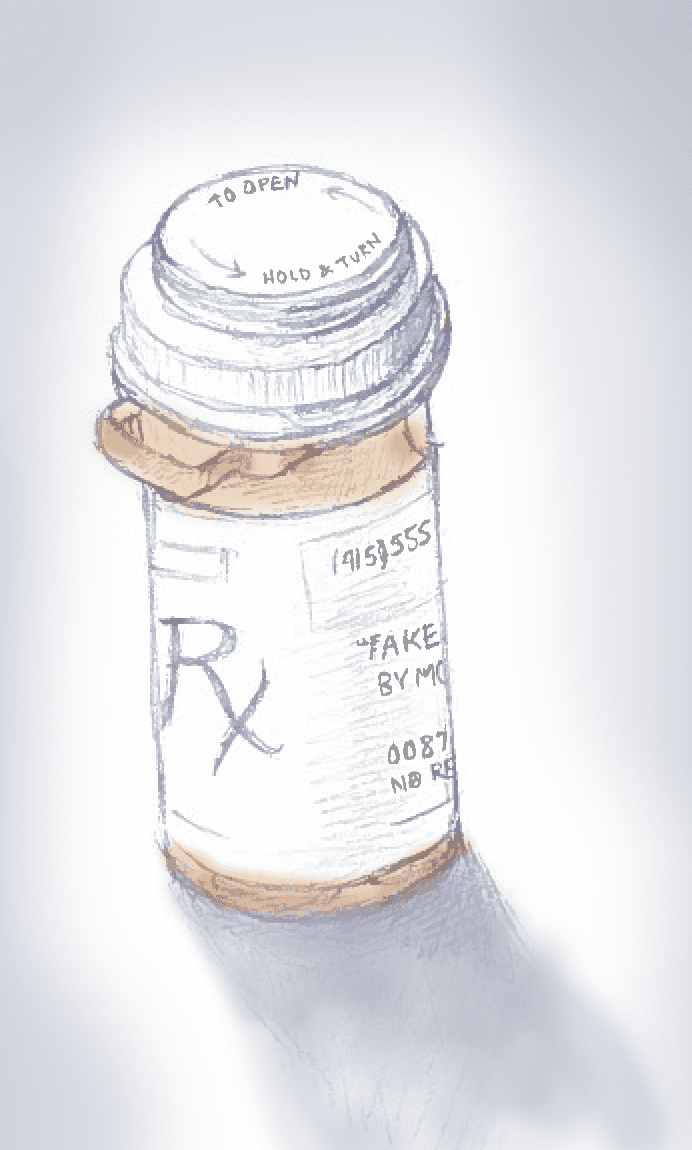Another invitation to dinner arrived in the mail today from Biogen Idec, manufacturers of Tecfidera®, the Tiffany-blue capsules I take every morning and evening to treat multiple sclerosis. Usually the invites are for dinner at a chain restaurant, like Bucco di Beppo, somewhere in the San Fernando Valley. I noticed this one because it was for The Wine Cask, an upscale restaurant in Santa Barbara. My husband and I had eaten there once using a gift certificate we had bought at a charity auction. It’s fancy and not the kind of place I’d expect to be invited to for any group event other than a celebration hosted by a well-to-do friend. I was momentarily tempted to go, then I remembered I was already taking Biogen’s medicine and I didn’t want to spend my free time dwelling any further on the disease for which I am taking it.
Over the past year I’ve received five or six such invitations from Biogen. In addition to dinner, the format includes a talk with a Q&A by a local neurologist, who I assume is being paid by the drug company to participate in the event. While couched in the language of general outreach to MS patients, the presumed outcome is to get more people signed up to take Tecfidera®. As someone who has been on the drug for over a year now, it’s a mystery to me why I continue to be wooed. Whether Biogen’s customer relationship management software isn’t sophisticated enough to differentiate users from prospects or their hope is that a free dinner will be enough to turn me into an otherwise unpaid evangelist for their drug, I don’t know. What I do know is how weird it is that customer relationship management, or CRM in corporate marketing lingo, is part of the lexicon of the American healthcare system. The unavoidable truth is that I, as a patient with a chronic disease that is statistically likely to have only a negligible impact on my lifespan, am a pharmaceutical company’s wet dream. When it comes to customer lifetime value, I, along with the nearly half of the American population that suffers from chronic conditions, am the gold standard for big pharma. Thanks to the American healthcare system, our identities as patients have been subsumed by our identities as consumers.
The marketing of healthcare to Americans is, along with the prevalence of mass shootings, one of the most disturbing phenomena I have encountered since moving back to the US in 2011, after six years of living in the UK. Although it’s been legal in the US since 1985, I first started to really notice pharma advertising on visits back to the US when I was still living in England. There you could say that television is socialized in much the same way as their medicine, which means that in exchange for an annual, mandatory television license payer’s fee, I received commercial-free television on the BBC. More to the point, direct-to-consumer advertising of pharmaceutical drugs is prohibited, as it is in most countries around the world. This made it all the more jarring to encounter prescription drug advertising-riddled American television on our return visits. Whether you had diabetes, erectile dysfunction, or depression, there was an affluent, jovial, often-dancing couple on tap to demonstrate that you, too, could overcome your disease. As cringeworthy as these ads are, the fact that they are delivered via the mass media conduit of television is somehow less objectionable than being personally targeted via direct mail by your drug company, even if they are asking you to dinner.
Advances from my drug company aside, perhaps the most disarming part of having multiple sclerosis is that I don’t feel sick. This explains why, 18 months after being diagnosed, I still have a hard time calling myself sick. I have no outward signs of being unwell. Nothing, say, that would come in handy for allowing me to heed the call to board a plane early without inciting stares of hatred. “There’s nothing wrong with her!” I can practically hear the crowd hissing. For this, every time a gate attendant invites passengers onboard who need a little extra time, I feel a tiny bit bitter. Couldn’t this disease be decent enough to come with perks?
And yet, despite my seeming glow of health, it turns out I am sick. About thirty tiny white flecks that show up on a picture of my brain taken by inserting my head into a giant cylinder that sounds like a construction site—these are the evidence of my disease. They are lesions, or les ions as I occasionally call them in a wan attempt to give some va-va-voom to a word that has none. Lesions, after all, are for lepers, who I think we can all agree are the most lacking in va-va-voom among the general population of the sick.
I knew I was officially going to be designated as sick when I woke up one day in December 2012 with the side of my face feeling like it had been violated by an overeager, Novocain-wielding dentist. Numbness was one of the persistent neurological symptoms that had been, according to my then-neurologist, the evidence I was at high risk to develop MS back in 2009. But since such symptoms had only occurred once, they were considered a clinically isolated incident. In order to be diagnosed, I would have to experience a second such incident; that’s what the multiple in multiple sclerosis means. When I asked my neurologist how I would know if I was experiencing persistent neurological symptoms, he had told me I would “just know.” He was right, but still I waited three days before I drove myself to an urgent care facility on that December Saturday morning and blubbered to the attending physician that I feared I had MS.
*
Tecfidera® is a relatively new treatment—FDA approved in March 2013—for relapse-remitting MS, the most common form of the disease. It’s significant because it is an oral therapy, i.e., a pill that you take twice a day. Before Tecfidera®, the most common treatments, including Avonex®, the one I was initially prescribed, were self-administered shots. For a needle-phobe like me, learning to inject myself was traumatic enough, but, to add insult to injury, the medication had unpleasant side effects. For the one day per week I took it, I essentially gave myself a 16-hour flu. I felt exhausted and achy and needed to go to bed. It was no way to live, especially given that I was treating a disease that had symptoms that thus far manifested rarely (about once every four years in my case) and, when they did, were annoying rather than disabling. It was one of those cases where the medicine seemed worse than the disease, and I jumped at the chance to switch to Tecfidera® when it was approved. Other MS patients also flocked to Tecfidera®, and in their 2013 annual report, Biogen’s CEO, George A. Scangos, noted that it “may prove to be one of the most successful launches in the history of our industry.”
My direct relationship with Biogen had started when I was prescribed Avonex®, their declining-but-still-bestselling MS drug, and somehow enrolled in their MS ActiveSource program®. I say “somehow” because, in the distress of being diagnosed with MS, I don’t remember signing anything that disclosed my personal information directly to the drug company. On its website, Biogen bills its MS ActiveSource® program as “a resource dedicated to helping people with multiple sclerosis live better lives.” The legal disclaimer on the site notes that the information is intended for US residents only. In other words, there’s enough marketing in this “resource” that it’s not offered in other countries. In the days after I had been prescribed Avonex®, MS ActiveSource® contacted me and arranged for a nurse to come to my home to teach me how to use an Avonex® pen to inject myself. It was a helpful service, but it was confusing that it was being provided by the drug company instead of my healthcare professionals. Still, in the aftermath of my diagnosis, my focus was not on answering questions about the seeming dysfunction of the American healthcare industrial complex. That would come later.
When my prescription was switched from Avonex® to Tecfidera®, I do remember willingly disclosing my personal information to Biogen. My neurologist told me to download a form from Biogen’s Tecfidera® website that we would then jointly complete and she would fax back to Biogen. Re-reading the form now, I see that my disclosure was not mandatory, although Biogen states on the form that doing so will expedite the patient’s enrollment into their QuickStart and $0 Copay programs. The QuickStart program ensures that patients with medical insurance will get started on Tecfidera® within two weeks. My medicine was making me sick and I wanted to start on Tecfidera® right away. I filled in my personal details, including email address and phone number, and gave the form back to my neurologist.
My decision to take advantage of Tecfidera®’s $10 (now $0) Copay program came later, in January of 2014, when my prescription drug company, Express Scripts, changed the reimbursement tier of Tecfidera®, thereby requiring me to pick up additional cost. Eligibility to participate in the program is fairly broad, although it excludes people on federal plans like Medicare, Medicaid, and the VA/DoD, a category of patients who would presumably benefit most from such assistance. There are also limitations that vary by insurance company. Still, the existence of the plan is likely another reason that adoption of the drug has been so rapid.
Part of me is grateful for the financial assistance extended by Biogen, and yet the cynic in me is not quieted. After all, Biogen Idec is not giving me the medicine for $10 per month. Express Scripts still pays them for the drug, the wholesale price of which is $54,900 per year, although the pharmaceutical companies negotiate discounts on those prices. And, my employer and I still pay Express Scripts. Both the drug company and the pharmacy company are doing exceptionally well. Express Scripts Holdings is number 20 on the Fortune 500 2014 and made $1.9 billion dollars in profit in 2013. Biogen Idec sits at 375 on the Fortune 500 2014 and, coincidentally, also made nearly $1.9 billion dollars in profit in 2013. The magnitude of these profits produces cognitive dissonance in me: I am equally morally outraged and tempted to buy their stocks as a kind of insurance plan to ensure I can continue to afford the drugs I will need in the future.
I can’t shake the feeling that the copay programs at big pharma companies have a whiff of the tactics of crack dealers: get the customer hooked, then raise the price. There is evidence to back up my notion. While Biogen has not pulled their copay plans on older therapies like Avonex®, the wholesale price of that drug has risen 147% between late 2007 and 2014, putting the cost per weekly injection up to $1,363.50. Because the copay plan remains in place, the direct link between the rising cost of that drug and the rising cost of Americans’ medical care is blurred. But the pharmacy companies still have to bear the cost of the price increases, which consumers and employers in turn bear in the form of premium rises. It seems to me it would be simpler to ditch the copay and patient outreach programs, like MS ActiveSource®, and use the savings to reduce the price of the drugs. But then, perhaps, big pharma would seem less benevolent. That would make two less layers in the American healthcare complex in which to hide.
This phenomenon of pharmaceutical price inflation is not unique to Biogen Idec. Across the industry, prices are rising in an apparent attempt to offset revenue declines from patent expirations. When asked to comment on this phenomenon in a May 2014 article in Bloomberg Businessweek, a spokeswomen for Biogen noted the pricing for Avonex® was comparable to the competition, a comment that seems tantamount to the corporate PR version of saying all the other kids are jumping off the bridge so we’re going to do it, too. Keeping in mind that we’re starting from a higher price point in America than elsewhere in the world, the situation is even worse. For example, in the UK, Tecfidera® costs £17,000 per year, just under half the wholesale cost in the U.S. The discrepancy is largely down to the negotiating power the UK’s National Health Service (NHS) wields as a single buyer. In contrast, the biggest buyer in the American healthcare system, Medicare, is forbidden by law to negotiate directly with drug companies. The bottom line is Americans pay more because the drug companies can get away with it.
There are, of course, downsides to the UK’s NHS, and one of them is that, due in part to these price negotiations, it generally takes longer for new medicines to be approved there than in America. Tecfidera® was approved in England in August 2014, 18 months after it came to market in the US.
*
In May, another dinner invitation from Biogen Idec arrived in the mail, and this time, thinking it could be something interesting to write about, I decided to go. The morning before my date with the drug company I spent some time on the Internet. First, I visited ProPublica’s Dollars for Docs tool, which has aggregated data disclosed by a subset of pharmaceutical companies (Biogen is not one of them) on payments made to healthcare providers since 2009. Records for Dr. Orfuss, the neurologist who was the keynote speaker for the evening’s event, showed he had accepted meals from Cephalon in 2012 totaling $259, a figure that hardly seemed damning. Next I looked up the dinner menu of the Daily Grill, our designated rendezvous spot. In my feeble attempt to stick it to the man, I decided I would have the blue cheese-crusted filet because it was the most expensive thing on the menu. My planning was for naught, though, because on arrival I was presented with a set menu consisting of a mixed field greens salad and a choice of herb chicken Caprese or pasta primavera. And I would have to pay for the glass of Pinot Grigio I needed so badly.
The room was comprised of mixed race and gender adults, and I was illogically startled to see several walkers and wheelchairs in use by the attendees. There were more women than men, reflecting the reality that the disease affects women two to three times more than men. I took a seat at a table with two African American men, who turned out to be the father and brother of a man with MS. We passed a basket of bread and made small talk while we waited for the presentation to start.
A sparky woman representative from the drug company kicked the evening off with a brief introduction to Tecfidera® and Dr. Orfuss. The potted biography of Tecfidera® included the information that 65,000 people were taking it, which put it in the top five drugs as measured by growth in their first year. With the wistfulness of a mother of a child who had just missed a spot on a sports team, she noted that it had been top three until a Hep C drug had overtaken it.
Dr. Orfuss was a gray-haired Caucasian man wearing glasses, a pager, and a navy-blue blazer with a stain on the bottom corner. He took a sip from a glass of red wine—which I couldn’t help thinking he probably didn’t have to pay for—before starting a drug company-scripted PowerPoint presentation covering the basics of MS and Biogen Idec’s role in treating more than 50% of the MS patients in the US through one of their five MS medicines. Anyone could have given the presentation, which Dr. Orfuss more or less admitted when he warned us in advance he was supposed to stick to the slide deck and tell us to talk to our doctors in response to almost all questions. The only sense I got of him as a person was when he nerded out with an appealingly, almost-childish glee in his description of the various types of lesions that present in the nervous systems of MS patients. That longish lesions around ventricle-based veins are known as Dawson’s fingers and that lesions classed as T1s are permanent black holes also struck me as things I could find interesting if they weren’t so likely to happen in my brain. Later Dr. Orfuss dared to go slightly off-piste and tell us that he doesn’t often diagnose secondary progressive MS—a severe form of the disease—because, perversely, insurance tends not to cover that diagnosis.
Our final speaker of the evening, a middle-aged woman with MS who was taking Tecfidera®, took the microphone just as my pasta primavera arrived. She was blonde and bubbly, wearing black yoga pants and a lacy top. She told the story of her diagnosis and encouraged us to take advantage of the perks of having a disability, which she liked to think of as leveling the playing field. The perks, which she enumerated at some length, included free National Park passes, discounts on electric and gas bills, discounts on Amtrak tickets, and disabled parking permits. At the mention of the last, the neurologist, who had been shifting in his seat, felt compelled to interject and ask the room not to use a handicapped parking permit unless we really needed one.
I still haven’t taken advantage of any of those perks, partially because of the moral dilemma around doing so when I am not disabled in any sense of the word, but mostly because, to do so, would be to admit that I am sick.
At the end of the evening, as plates of brownies and cookies were being passed around the tables, the sparky drug company representative approached me and, having noticed I was taking notes throughout the presentation, asked me if I had any questions. I asked her if she knew how the economics of the Biogen Idec copay programs worked. She said she didn’t, but emphasized with seeming sincerity the patient-centered ethos of Biogen espoused by their CEO, who she noted started as a scientist (Mr. Scangos’s bio on the Biogen Idec website states he was a Professor of Biology for six years at John Hopkins University). She seemed happy to work there. I paid the tab for my glass of Pinot Grigio and went home.
The next morning I reflected on how my “date” had gone. The verdict: nice-enough-seeming guy, but not relationship material. Medicine aside, there was just no chemistry in my attempt to have a personal relationship with my drug company. As if they’ve gotten the hint, lately I’ve noticed Biogen Idec’s courting has taken a distinctly professional turn. They’ve stopped inviting me to dinners and started inviting me to webinars for Tysabri®, another drug in their stable of MS treatments. Perhaps their customer relationship management software is more sophisticated than I gave it credit for.
***
Rumpus original art by Sylvia Nguyen.







